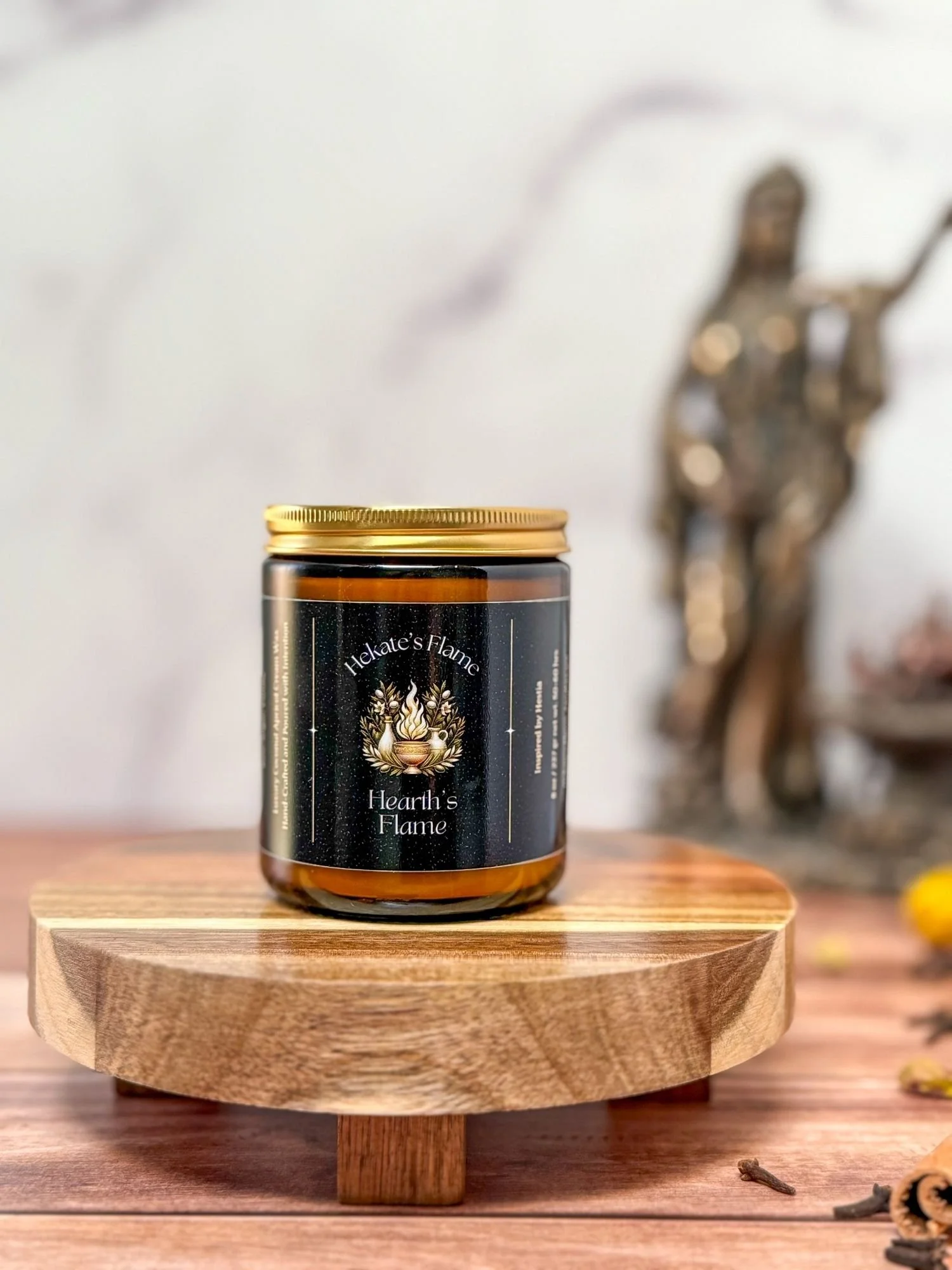‘Bloom & Shadow’: a handmade artisanal candle inspired by Persephone, the Greek goddess of spring and queen of the underworld
She who walks between worlds and carries spring in her shadow
Imagine sunlight breaking through the earth after a long winter, blossoms stirring above, roots still deep in shadow. That’s the heart of Bloom & Shadow: orange blossom and cherry blossom bright with spring’s sweetness, plum and pomegranate rich and ripe beneath, and bamboo and beechwood grounding it all in quiet strength. A scent of return and remembrance, light born from darkness, like Persephone herself.
Scent Notes:
Top: Orange Blossom, Cherry Blossom, Key Lime, Clean Cotton
Heart: Plum, Pomegranate
Base: Bamboo, Beechwood
🌸 Season Scent: Spring
🌹 Primary Scent Family: Floral
🍋 Secondary Scent Family: Citrus & Fruity
Please visit this blog post for more information on Scent Profiles, Top, Heart, and Base Notes.
Our candles are lovingly handcrafted in our home studio, Nimue’s Lair, nestled in Walnut Creek, CA. Each one begins with a luxurious blend of coconut-apricot wax, carefully infused with premium fragrance oils. Poured by hand into elegant glass vessels and amber jars, they’re finished with hand-cut labels and enchanted final touches. Every candle is a small ritual, infused with magick, intention, and the quiet glow of story.
-
12 oz Deluxe – Amber Aura Glass · Coco Apricot Wax
Burn Time: 60+ hours
Bold and enduring, this candle fills your space with myth and memory. Crafted for spacious sanctuaries, this candle shines in wide-open living rooms, high-ceilinged studios, and sacred hearths ~ places where scent is free to roam and the flame becomes a luminous companion to stillness and story.8 oz Classic – Amber Jar · Coco Apricot Wax
Burn Time: 50–60 hours
A perfect size for quiet corners and thoughtful pauses. Let it warm your reading nook, home office, or bedside altar, where its flame flickers like a whisper of intention.4 oz Petite – Amber Jar · Coco Apricot Wax
Burn Time: 20–25 hours
Small in size, rich in presence. This candle is ideal for travel, gifting, or sanctifying intimate spaces - guest rooms, personal altars, or quiet corners where scent and flame are invited to linger with intention. -
For detailed information about our waxes, wicks, fragrance blends, and vessels, please see our Ingredients & Materials Guide.
-
For guidance on how to tend your flame with care, ensuring the cleanest, safest, and most enchanting burn, please visit our Candle Care Guide.
-
Please visit the Shipping and Returns Information page for details.
-
All photographs, images, and written content on this website are original works of Hekate's Torch Apothecary, LLC (doing business as Hekate’s Flame Apothecary) and are protected by copyright. They may not be used, altered, shared, or reposted on any platform without explicit written consent. All label designs, photos, images, and content are the exclusive property of Hekate's Torch Apothecary, LLC.
For inquiries regarding the use of our content, please contact: care@hekatesflame.com
© 2025 Hekate's Torch Apothecary, LLC. All rights reserved.
Content Warning:
This post explores ancient myths that include themes of violence, including assault and warfare, which may be sensitive for some readers. Please proceed with care and be mindful of your well-being while engaging with these stories.
Photo images from Unsplash.
Persephone: Goddess of Spring, Queen of the Underworld, and the Embodiment of Transformation
In Greek mythology, Persephone is a goddess of duality, embodying both the life-bringing force of spring and the transformative power of death. As Kore, the youthful "Maiden," she is tied to renewal and fertility. At the same time, as Persephone, Queen of the Underworld, she rules over the dead and presides over the darker mysteries of existence. Her tale is one of contrasts: a life divided between two worlds, innocence and power, abduction and autonomy.
Her mythology, deeply intertwined with that of her mother, Demeter, reflects the cycles of nature, particularly the changing of the seasons, and offers a profound exploration of grief, transformation, and renewal. The myth of Persephone and Demeter was also central to the Thesmophoria, an autumn festival celebrated by married women throughout the Greek world. The festival symbolized both agricultural fertility and human procreation, with its rituals and sacrifices evoking the descent and return of Persephone.
Persephone's Epithets and Titles: The Queen and the Maiden
Persephone's many names and epithets throughout Greek tradition emphasize her dual nature. As Kore, she is the beloved daughter of Demeter, the goddess of spring and growth. But in her role as Queen of the Underworld, Persephone is called by many other names, each highlighting a different aspect of her power and authority.
Homer describes her as agauē (venerable) and epainē (awesome), while she is also referred to as hagnē (demanding respect) and arrētos (whom none may name), emphasizing her sacred and formidable nature.
Other cult titles, such as Soteria (Savior), Despoina (Mistress), and Brimo (Angry or Terrifying), further underscore her commanding presence in the Underworld, where she is not merely Demeter's daughter but a force unto herself, demanding respect and awe from gods and mortals alike.
Together, Persephone and Demeter were often referred to as "The Two Goddesses" or "The Thesmophoroi," emphasizing their shared power over fertility, life, and the cycles of the natural world. These names were invoked in festivals such as the Thesmophoria, where women enacted rituals like casting pigs into underground pits, symbolizing decay and rebirth. The rotten remains were later brought to the surface and placed on altars, symbolizing Persephone's return from the Underworld and the renewal of life.
Persephone's Abduction by Hades: The Myth That Changed the Seasons
The most famous myth involving Persephone is her abduction by Hades. This event set into motion the shift of seasons and her transformation from Maiden to Queen. According to Hesiod's Theogony, Zeus, as king of the gods, played a significant role in this event by giving his tacit approval to Hades for the abduction. The Theogony emphasizes the patriarchal control that even gods were subject to, and Persephone's fate was largely sealed through Zeus' decisions, illustrating the lack of autonomy for female figures in both divine and mortal realms.
In another version from Pseudo-Apollodorus' Bibliotheca, Persephone was gathering flowers in a meadow on the plain of Nysa, accompanied by the Oceanids, nymphs of the great river. Lured by the beauty of a narcissus flower, which Hades had strategically placed, she strayed from her companions. The earth then split open, and Hades rose from the Underworld in his dark chariot to seize her.
Often depicted in art, this myth captures a range of emotions, such as fear, sorrow, and powerlessness. Persephone's cries echoed across the earth, but none responded except for her mother, Demeter. Yet, two others heard Persephone's cries: Hekate, the goddess of witchcraft and crossroads, who later played a crucial role in aiding Demeter's search. Though she hadn't witnessed the abduction, Hekate offered Demeter her guidance and support, embodying feminine solidarity in the face of grief.
It was Helios, the sun god, who ultimately revealed the truth. From his vantage point in the sky, Helios had seen everything and informed Demeter of her daughter's fate. In a detached manner, he attempted to rationalize the abduction, noting that Hades, though ruler of the Underworld, was a powerful and worthy god, suggesting that Persephone's enforced marriage was advantageous within the divine hierarchy. However, this revelation righteously enraged Demeter, for no title or status could justify her daughter being taken without consent.
With Zeus' tacit approval, Hades dragged Persephone into the depths of the Underworld, initiating her journey into the unknown. This violent act marks not only Persephone's physical abduction but also a symbolic death of her maidenhood, a moment when she is forcibly pulled from the innocence of youth into the darker, more complex realm of adulthood and power.
Demeter's Search for Persephone: A Mother's Devastation and the Earth's Despair
Demeter's response to her daughter's abduction is as much a part of Persephone's story as the abduction itself. Demeter's profound grief leads her to forsake her divine duties and plunge the earth into famine. Demeter's relentless search for Persephone, which takes her across the world, reflects the immense bond between mother and daughter, a bond that transcends even divine law. At the Thesmophoria, this sorrow was ritually reenacted, with sacrifices symbolizing Demeter's grief for her daughter and the cycles of death and rebirth. The Boeotians even called the festival a 'festival of sorrow' in honor of Demeter's mourning.
The earth's barren state during Persephone's absence mirrors Demeter's internal devastation. Through this myth, the Greeks explained the cycle of the seasons: the earth flourishes when Persephone is with her mother, and it withers when she is forced to return to the Underworld. This cycle reflects the natural rhythms of grief and healing, where the earth and Demeter must endure periods of barrenness before renewal.
Persephone and the Pomegranate: A Symbol of Fertility, Death, and Transformation
The pomegranate holds a deep significance in ancient mythology, not only as a symbol of fertility and death but also as a representation of forbidden knowledge or experience.
By consuming the seeds, Persephone's transformation from innocence to wisdom is symbolically complete. When Hades secretly offers Persephone the pomegranate seeds, he ensures her connection to the Underworld. In consuming the seeds, Persephone is bound to return for a part of each year. This act of eating food in the Underworld, a taboo in many ancient myths, signifies that Persephone can never fully return to the world of the living, forever tying her to both realms.
The pomegranate's dual nature, its association with fertility, and its link to death perfectly mirror Persephone's role. When she returns to the surface in spring, she symbolizes life, renewal, and fertility. Yet, she is also the Queen of the Underworld, presiding over death and the afterlife.
From Darkness to Bloom: Persephone's Journey and the Return of Spring
Persephone's ascent from the Underworld each spring is one of the most enduring symbols of renewal in ancient myth. As she returns to her mother, the earth awakens from its winter slumber, and life blooms once more. In this role, Persephone embodies the spirit of spring, fertility, and growth, a symbol of hope after a long period of dormancy. Her presence is tied to the flourishing of nature, making her integral to the Greeks' understanding of agriculture and the changing seasons.
This rebirth, however, is not without its cost. Persephone's time in the Underworld irrevocably changes her, adding a layer of complexity to her role as a goddess of spring. She is no longer the innocent maiden; her experience in the Underworld makes her more than a figure of pure fertility; she is also a reminder of life's fleeting nature, of the inevitable decay that follows growth.
Persephone's Authority in the Underworld: Justice, Mercy, and Power
In the Underworld, Persephone assumes a very different role. No longer the youthful maiden, she is the mighty Queen of the Dead, ruling alongside Hades. According to Pseudo-Apollodorus, as Queen, Persephone presides over the destinies of the souls of the dead.
She is depicted as having the authority to make crucial decisions regarding mortal fates, such as agreeing to let Heracles take Cerberus as part of his labors. Her power is not limited to passive rulership; she actively intervenes in mortals' and heroes' lives, determining who may return to the living and who remains in the Underworld.
As the goddess who presides over the passage from life to death, Persephone commands the destinies of souls, and everyone, heroes, mortals, and gods alike, will eventually come under her authority. In Homer's Odyssey, we learn that the seer Tiresias retains his reasoning abilities in death thanks to her. Persephone also commands the souls of the heroines to appear before Odysseus and subsequently disperses them, underscoring her power over the spirits of the dead. She is also linked to the Erinyes, goddesses of vengeance, who punish those guilty of crimes such as murder. Persephone's role in administering justice in the Underworld is crucial, as she helps maintain order in both the mortal and immortal realms.
This transformation into a sovereign queen illustrates a more profound empowerment, one often overlooked in traditional readings of her myth. Persephone is not a passive victim of her abduction; over time, she becomes a formidable ruler who commands respect and authority in the realm of the dead.
In some stories, Persephone is even depicted as merciful. For example, Sisyphus persuades her to let him return to the upper world to remind his wife of her duty to give him proper funerary rites. Similarly, Persephone is moved by Alcestis' self-sacrifice, and in one version of the story, she sends Alcestis back to the land of the living, a rare act of compassion. Her power to grant mercy or impose punishment is reflected in the story of Theseus and Pirithous, who attempted to abduct Persephone to make her Pirithous' bride. As punishment for their audacity, Persephone ensured that they were imprisoned in the Underworld. However, she later allowed Heracles to free Theseus. Pirithous, however, remained trapped as part of her divine retribution.
Her rule in the Underworld also highlights the contrast between her dual identities. Persephone embodies both life and death in the same way that the seasons shift between growth and dormancy. Although her authority is often associated with vengeance, particularly alongside Hades and the Erinyes (the Furies) in punishing murderers, Persephone is not implacable. She listens to reasonable requests and makes decisions with balance and fairness. For example, she allows Orpheus to lead his wife, Eurydice, back to the upper world because of his beautiful lyre playing. However, she stipulates the condition that he must not look back. This test ultimately results in Eurydice's return to the Underworld when Orpheus fails.
Persephone's Annual Return: A Reflection of Life's Seasons and Cycles
For the ancient Greeks, Persephone's myth explained the cycles of the seasons. Still, it also mirrors the human experience of loss and renewal. The earth's cycles, birth, growth, death, and rebirth, are reflected in Persephone's annual journey between the upper world and the Underworld. Her story reminds us that life's most painful losses can give way to renewal, much like winter gives way to spring.
This cyclical nature speaks to the deeper truths of existence: that life is not linear but composed of periods of growth and decline, each leading into the other. Persephone's myth invites us to find meaning in both the times of abundance and loss, trusting that each is part of the larger rhythm of life.
Persephone's Archetypal Journey: From Maiden to Queen of the Underworld
Persephone's transition from maiden to Queen is an archetypal journey of transformation. As the innocent maiden, she represents purity and potential; her descent into the Underworld and subsequent rise to power signify the maturation process that many people experience. Her story parallels the psychological journey from naivety to wisdom, from dependence to autonomy.
This transition speaks to the broader theme of individuation, where individuals confront their darker, unconscious aspects to grow into their full potential. Persephone's time in the Underworld can be seen as a symbolic descent into the unconscious, a place of shadows and hidden truths, from which she emerges stronger and more whole.
Persephone's Abduction: A Feminist Metaphor for Trauma and Empowerment
Some have interpreted Persephone's abduction as a metaphor for trauma, particularly in modern feminist readings of the myth. Her journey into the Underworld can be seen as a symbolic experience of descent into pain, suffering, and powerlessness. However, in later retellings of the myth, her eventual rise as Queen of the Underworld reflects the possibility of reclaiming power after trauma. In this way, Persephone becomes a symbol of survival, transformation, and the reclaiming of agency.
Her story resonates with those who have endured loss, trauma, or profound change, offering a narrative of hope that one can emerge from darkness not only healed but empowered. As Queen of the Underworld, Persephone demonstrates that it is possible to navigate both the light and the dark with grace and authority.
Proserpina and Pluto: Roman Views on Marriage, Seasons, and the Underworld
In Roman mythology, Persephone becomes Proserpina, but her story remains essentially unchanged. Proserpina's abduction by Pluto (the Roman equivalent of Hades) continues to explain the seasons, and her dual role as a goddess of spring and the Queen of the dead is preserved. However, in Roman culture, there is a slightly different emphasis on her marriage to Pluto, framing it as part of the Roman ideal of marital duty, which subtly shifts her portrayal toward a more accepted role as a wife rather than focusing on the violence of the abduction.
Eleusinian Mysteries and Persephone: Ancient Greece's Path to Eternal Life
The Eleusinian Mysteries revolved around both Demeter and Persephone. These secret rites were among the most sacred in ancient Greece, offering initiates the promise of a blessed afterlife and a deeper understanding of the cycle of life, death, and rebirth. Persephone's descent into the Underworld and her subsequent return were central to these ceremonies, symbolizing the soul's journey through death and its ultimate rebirth into the next world.
The Eleusinian Mysteries, held in Eleusis, provided followers with profound insights into the afterlife and the soul's journey, closely mirroring the themes of Persephone's dual nature as both a goddess of life and death.
Her return to life each spring was seen as a metaphor for the resurrection of the soul after death, offering initiates the hope that death was not an end but a transition to another form of existence.
Through the Eleusinian Mysteries, Persephone became not just a goddess of nature but also a spiritual guide, offering hope of eternal life. Her role as Queen of the Underworld in these rites reinforced her pivotal position in guiding souls through death and back to life, further cementing her importance in ancient Greek religion. With her story serving as a metaphor for the soul's transformation and the promise of immortality, Persephone's myth offered initiates a deeper understanding of the mysteries of life, death, and rebirth.
The Patriarchal Roots of Persephone's Abduction: A Reflection on Gender and Power
The abduction of Persephone reflects the patriarchal norms of ancient Greek society, where a woman's fate could be decided without her consent. Persephone's abduction by Hades, sanctioned by Zeus, mirrors the lack of autonomy many women faced in both myth and reality. Marriage, often arranged without the woman's input, became a form of male control where women were exchanged between fathers and husbands. Indeed, the myth of Persephone highlights the dynamics of power and control over female bodies, a theme that resonates with modern discussions of gender and agency.
Persephone's Myth: A Timeless Lesson on Loss, Renewal, and Transformation
Persephone's dual nature, as both a goddess of life and a queen of death, continues to offer profound insights into the cycles of existence. Her myth speaks to the human experience of loss, renewal, and the delicate balance between joy and sorrow, life and death. In Persephone, we find a goddess who navigates both the light and the dark with grace, authority, and resilience. Her story reminds us that transformation often requires us to descend into the depths before we can rise again, stronger and more whole.



































































































